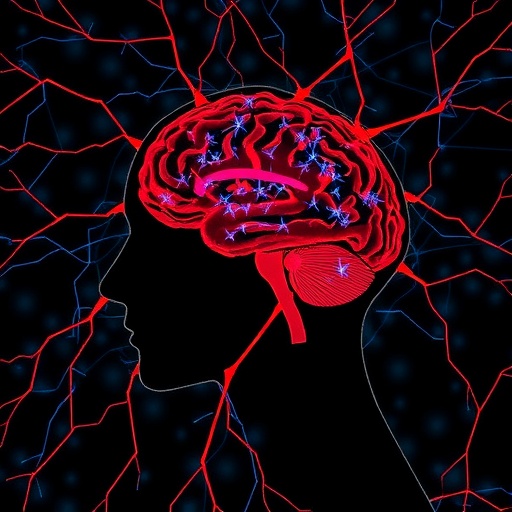In a groundbreaking new study published in BMC Psychiatry, researchers have delved into the complex interplay between homocysteine levels, cognitive deficits, and spontaneous brain activity alterations in individuals with bipolar disorder exhibiting suicidal ideation. This investigation brings to light novel insights into the nuanced neurobiological underpinnings of suicidality in bipolar disorder, opening promising avenues for targeted interventions and diagnostics.
Bipolar disorder (BD), a chronic psychiatric condition characterized by mood swings ranging from depressive lows to manic highs, often presents with an alarming complication: suicidal ideation (SI). It is widely acknowledged that patients grappling with BD and concurrent SI demonstrate distinctive brain functional abnormalities and altered biochemical markers. Among these, homocysteine (Hcy)—an amino acid derivative linked to neurotoxicity and vascular dysfunction—has emerged as a molecule of interest, implicated in neuropsychiatric disorders but still inadequately understood in the context of bipolar suicidality.
The study enrolled 74 participants, segmented into three cohorts: twenty individuals diagnosed with BD and active SI (BDSI), twenty-four BD patients without suicidal ideation (BDNSI), and thirty healthy controls (HC) matched by age and sex. This design allowed for a thorough comparative analysis that distinguishes the neurochemical and neurofunctional alterations specific to suicidal symptomology in BD versus the broader disease pathology.
Central to this research was the examination of the amplitude of low-frequency fluctuation (ALFF), a resting-state functional magnetic resonance imaging (rs-fMRI) biomarker that quantifies spontaneous neural activity variations in the brain. ALFF has been increasingly recognized for its ability to detect aberrant functional dynamics in diverse psychiatric conditions, illuminating altered neurocircuits that could underlie symptom emergence. In complement, detailed cognitive assessments targeting verbal and visual learning, core domains often impaired in BD, were administered to evaluate the extent of cognitive deficits in relation to brain activity and biochemical markers.
One of the most striking findings was the differential homocysteine profile between BD subgroups. Contrary to initial expectations, Hcy concentrations were significantly elevated in BD patients without suicidal ideation compared to those exhibiting SI. This challenges the simplistic view that higher homocysteine universally correlates with increased suicidality risk, hinting instead at distinct pathophysiological trajectories within BD populations.
Furthermore, in the BDSI cohort, homocysteine levels positively correlated with fractional ALFF (fALFF) signals in the left posterior cingulate gyrus—a critical brain region involved in self-referential processing, emotional regulation, and integration of cognitive functions. This region’s heightened low-frequency activity correlated strongly with homocysteine, indicating that biochemical imbalances may directly modulate spontaneous neural dynamics associated with suicidal thoughts.
Mediation analyses revealed that spontaneous activity alterations in the left posterior cingulate gyrus significantly mediated the detrimental relationship between elevated homocysteine and impairments in both verbal and visual learning domains. In other words, homocysteine’s negative impact on cognitive performance in BDSI patients appears to be channeled through its effect on abnormal brain activity, offering compelling evidence of a neurobiological mechanism bridging peripheral biochemistry and central cognitive functions.
These findings provide a multifaceted view on the interface of neurochemistry, brain function, and behavioral symptoms in bipolar disorder with suicidality. Notably, the divergence in homocysteine patterns between suicidal and non-suicidal BD groups suggests that the traditional biomarkers of psychiatric risk require context-dependent interpretation. The involvement of the posterior cingulate cortex underscores the necessity to focus on specific brain networks rather than broad regional assessments when exploring mood disorders complicated by suicidality.
The clinical implications of this research are profound. By elucidating the mediating role of spontaneous low-frequency brain activity in the cognitive consequences of disrupted homocysteine metabolism, the study highlights potential targets for therapeutic intervention. Modulating either homocysteine levels through dietary or pharmacological means or directly targeting aberrant neural fluctuations via neuromodulation could ameliorate cognitive deficits and reduce suicidal ideation.
Moreover, this research advances the understanding that bipolar disorder is not monolithic but instead comprises heterogeneous subtypes with distinct biological signatures. Recognizing this heterogeneity is critical for the development of personalized treatment strategies and more precise risk assessments that could ultimately improve prognosis and quality of life for individuals afflicted by this challenging disorder.
On the methodological front, integrating biochemical assays with sophisticated neuroimaging and cognitive testing exemplifies the power of a multimodal approach in psychiatric research. Resting-state fMRI metrics like ALFF provide invaluable insight into intrinsic brain activity patterns that are often invisible through conventional imaging or clinical evaluations alone, advancing the frontier of brain-behavior correlation studies.
Future lines of inquiry prompted by this study include longitudinal tracking of homocysteine and ALFF measures to decipher causal relationships and potential predictive value for suicidal risk. Furthermore, incorporating genetic and epigenetic data could unravel how individual susceptibility factors intersect with biochemical and neurofunctional markers in bipolar suicidality.
In sum, this pioneering investigation transcends previous research by delineating a tripartite connection among homocysteine levels, cognitive dysfunction, and brain activity abnormalities in bipolar disorder patients with suicidal ideation. It marks a critical step toward decoding the biological intricacies of suicidality within mood disorders, fostering hope for innovative diagnostic tools and targeted therapeutics tailored to these vulnerable populations.
As mental health challenges escalate globally, especially amidst mood disorders marked by high suicide rates, such research underscores the urgent need for integrative neuropsychiatric investigations. Unraveling the biochemical and neural substrates of cognitive impairments and suicidality will not only transform clinical care but also illuminate fundamental processes governing human brain function and mental wellness.
Subject of Research: The study investigates the interrelationship among homocysteine levels, cognitive deficits, and spontaneous brain activity (measured via low-frequency fluctuations) specifically in individuals with bipolar disorder presenting suicidal ideation.
Article Title: Differential relationships among homocysteine levels, cognitive deficits, and low-frequency fluctuation in brain activity in bipolar disorder with suicidal ideation
Article References:
Huang, Y., Zhou, S., Feng, S. et al. Differential relationships among homocysteine levels, cognitive deficits, and low-frequency fluctuation in brain activity in bipolar disorder with suicidal ideation. BMC Psychiatry 25, 514 (2025). https://doi.org/10.1186/s12888-025-06925-x
Image Credits: AI Generated




